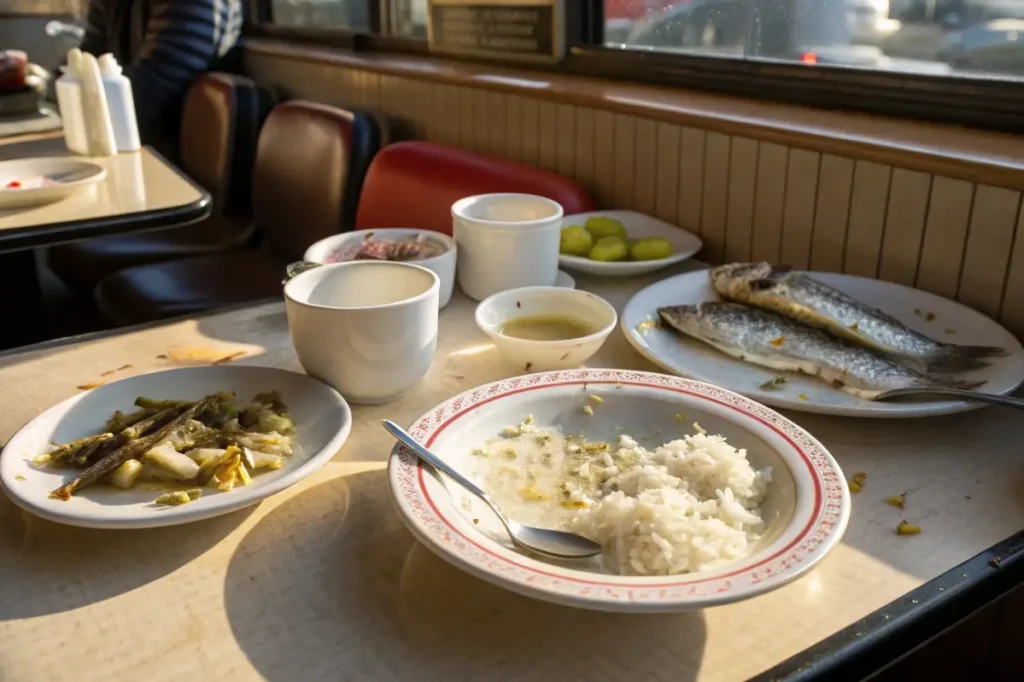A typical Japanese breakfast is more than just a morning meal—it’s a ritual blending age-old customs with the demands of modern life. Often featuring steamed rice, miso soup, and grilled fish, this culinary tradition emphasizes balance, flavor, and visual harmony. Whether you’re exploring local cafés in Tokyo or trying to replicate a traditional Japanese breakfast at home, understanding the fundamentals of Japan’s morning fare can deepen your appreciation for its culture and reveal new ways to begin your day.
From nori (dried seaweed) to pickled vegetables (tsukemono), each item complements the others, providing a range of tastes—salty, savory, tangy, and sweet. Contemporary Japanese families might also incorporate global influences, such as toast or coffee, without abandoning their classic staples. In this article, we’ll delve into what constitutes a typical Japanese breakfast, how its components evolved, and practical ways for you to adapt these meals into your daily routine. We’ll also reference helpful recipes—like traditional-japanese-breakfast—so you can see real examples of morning dishes that continue to charm both locals and travelers.
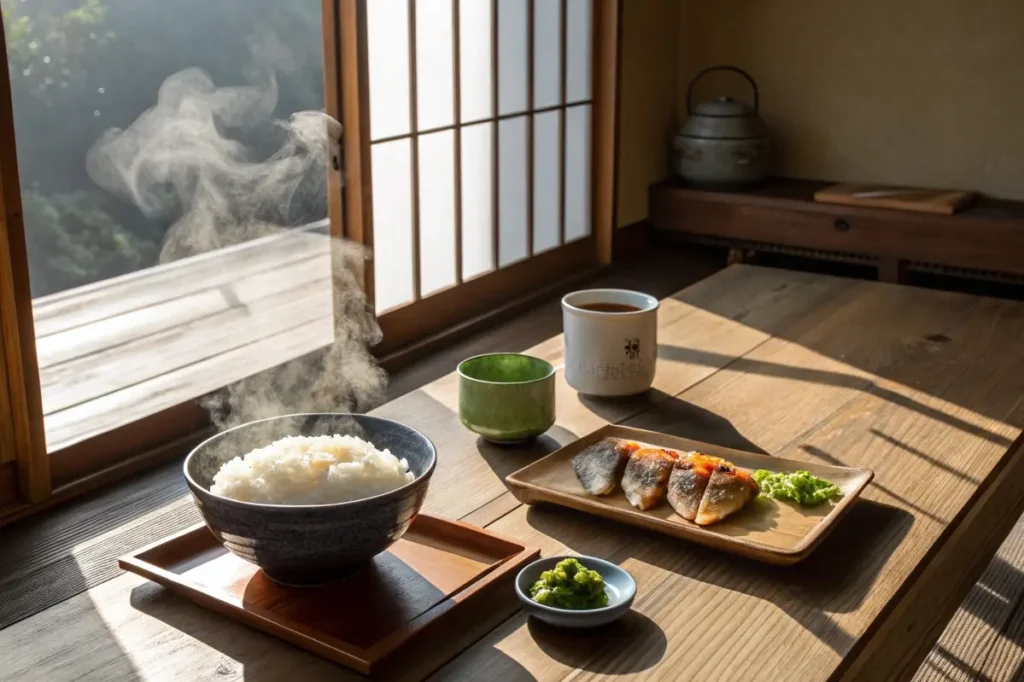
Core Components of a Typical Japanese Breakfast
A typical Japanese breakfast centers on simplicity, nourishment, and harmony among flavors. While there are countless regional variations, you’ll usually find the following key items at the table:
- Steamed Rice (Gohan)
- Short-grain white rice forms the staple carb, delivering a satisfying chew and mild taste.
- Some health-conscious families opt for mixed-grain rice or brown rice for added fiber.
- Miso Soup (Misoshiru)
- Made by dissolving miso paste in a dashi (broth) base, often with tofu, seaweed, and seasonal vegetables.
- Warm, comforting, and full of probiotic-rich fermented goodness.
- Grilled Fish (Yakizakana)
- Salmon, mackerel, or other fish lightly seasoned with salt or soy sauce, then grilled or broiled.
- Offers lean protein and a slightly smoky flavor, enhancing the mildness of rice.
- Pickled Vegetables (Tsukemono)
- Crisp, tangy vegetables like takuan (pickled daikon) or pickled cucumbers.
- Balance the meal’s heavier components while aiding digestion.
- Nori (Dried Seaweed) or Furikake
- Nori sheets can wrap around small bites of rice, while furikake is a sprinkle of dried flakes—fish, seaweed, sesame seeds—added over rice for flavor and texture.
- Eggs (Optional but Common)
- Tamagoyaki (rolled omelet) is the classic sweet-savory option.
- Soft-boiled or scrambled eggs may also appear, especially in modern households pressed for time.
Why These Staples?
Japan’s culinary philosophy values a mix of tastes and textures, so these elements combine to satisfy salty, savory, and even sweet cravings in one setting. By introducing diverse nutrients—carbohydrates, proteins, vitamins—this morning lineup fuels daily activities.
Everyday or Special Occasion?
Some families enjoy a typical Japanese breakfast daily, while others reserve the full spread for weekends. On busy weekdays, quick fixes like instant miso soup or leftover japanese-chicken-fried-rice-recipe-2 might stand in for grilled fish. If you’re curious about how vegetables can boost your meal, check out vegetables-japanese-recipe for plant-based ideas that fit seamlessly into morning routines.
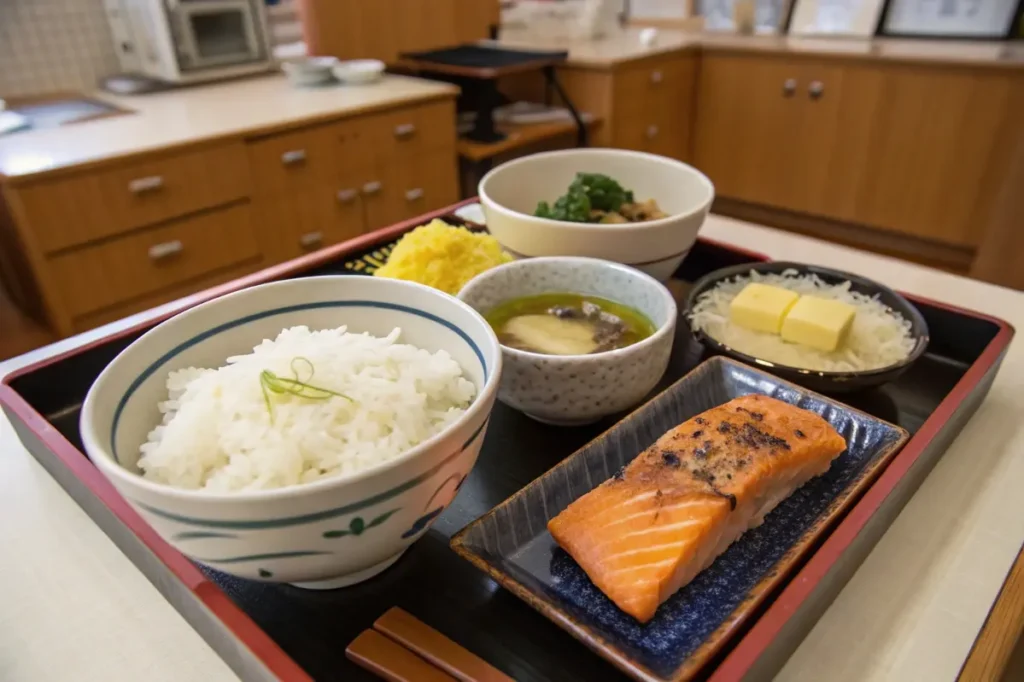
Understanding the “Japanese Breakfast Rule”
What is the Japanese breakfast rule? While not an official regulation, this term highlights the cultural emphasis on a balanced morning meal. It involves combining:
- Carbs: Rice or bread.
- Protein: Fish, eggs, tofu, or leftover meat.
- Vegetables: Soup ingredients or pickles.
By ensuring each category appears on the table, you naturally hit multiple food groups in one sitting. This approach mirrors Japan’s broader dietary guidelines, prioritizing variety and portion control.
Meal Timing: What Time Do Japanese Eat Breakfast?
Most families aim to eat breakfast between 6:30 and 8:00 AM, aligning with school and work schedules. Students might rush out with a small bowl of miso soup and rice, or even toast and jam if the schedule is tight. Weekends see more leisurely breakfasts—some enjoy extended brunches that begin around 9:00 or 10:00 AM, featuring extra sides like fruit or dessert. For a deeper dive into sweet breakfast inspirations, see japanese-dessert-recipes if you want to add a treat like matcha pancakes or sweet azuki beans to your morning.
Applying the Rule in Everyday Life
- At Home: Even if you have only 10 minutes, a cup of instant miso soup, microwaved leftover rice, and a quick protein source (e.g., a scrambled egg) can fulfill the “rule.”
- At Work: Office pantries often stock instant miso soup packets. Paired with a small bento or onigiri, you replicate much of the typical Japanese breakfast at your desk.
- Cafés and Hotels: Many hotels offer a “Japanese set” that includes fish, rice, soup, and pickled items. This perfectly illustrates the balanced formula. Meanwhile, cafés may serve “morning sets” with toast, boiled eggs, and coffee, blending Western convenience with a nod to local traditions.
Kids Before School
What do Japanese have for breakfast before school? Younger ones might eat a smaller portion of the classic set—think half a bowl of rice, miso soup, and a side of tamagoyaki or fish. Busy parents sometimes turn to convenience store options like onigiri or bread with chocolate spread, especially if time is short. However, many still strive for the “rule,” ensuring kids leave home with a balanced start. If you need recipes to engage picky eaters, try easy-japanese-tuna-salad-recipe-quick-and-delicious as a protein-packed side.
Ultimately, the “Japanese breakfast rule” highlights moderation, variety, and mindful consumption. Even modern, rushed lifestyles often maintain these principles, proving that tradition remains adaptable. Whether you have a few minutes or a full morning to spare, you can incorporate these guidelines into your routine.
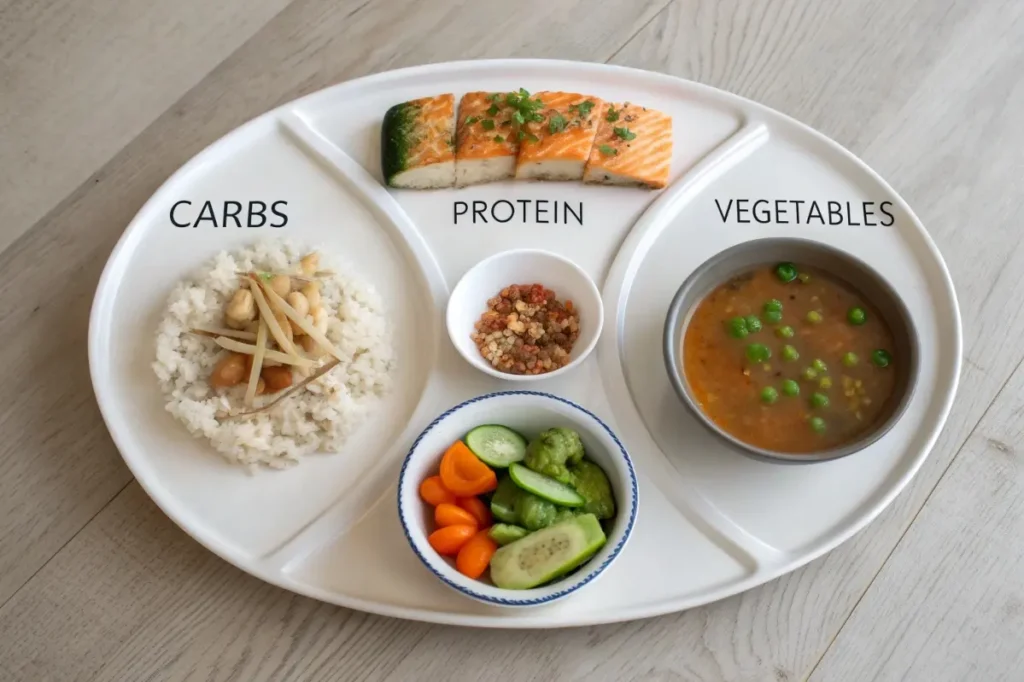
Modern Twists on a Typical Japanese Breakfast
Although tradition remains strong, many households adapt morning meals to fit changing schedules, tastes, and global influences. It’s not uncommon to see:
- Western Elements
- Toast: Thick-sliced Japanese milk bread (shokupan) topped with butter or jam.
- Coffee or Tea: Replacing or accompanying green tea in the morning.
- Cereal: Gaining popularity with children who crave convenience and sweetness.
- Leftovers
- Repurposing leftover japanese-curry-recipe-one-piece or stir-fry for a speedy breakfast.
- Adding a fried egg or cheese can transform dinner remnants into a hearty morning dish.
- Fusion Dishes
- Avocado Miso Toast: Mashing avocado with a bit of miso paste, spread on toast, often garnished with sesame seeds.
- Bacon and Egg Onigiri: Wrapping bacon and scrambled egg inside rice for a portable meal.
- Instant or Microwavable Foods
- Packaged frozen fish, pre-cooked and portioned for easy reheating.
- Instant miso soup or tofu pouches that blend hot water with dehydrated ingredients.
- Quick ramen or noodles-japanese-pan-noodles-recipe leftover that can be microwaved.
Convenience Store Culture
In Japan, konbini (convenience stores) are everywhere, offering onigiri, sandwiches, bottled coffee, and fruit cups. This setup appeals to salarymen and students who need a grab-and-go solution. While not as elaborate as homemade meals, they still provide essential nutrients: rice, fish or tuna, perhaps a pickled plum (umeboshi).
Why These Twists Thrive
- Time Constraints: Many Japanese juggle long commutes or extra-curriculars, leaving limited time for cooking elaborate breakfasts.
- Global Palate: Exposure to Western TV shows, travel, and social media encourages experiments with bread, jam, or even cold cereal.
- Sustainability: Minimizing waste by using leftover dinner items for breakfast is both economical and eco-friendly.
If you’re fascinated by how modern Japanese breakfasts adopt foreign elements without losing their cultural essence, check out modern-japanese-breakfast to see examples of East-meets-West morning meals.
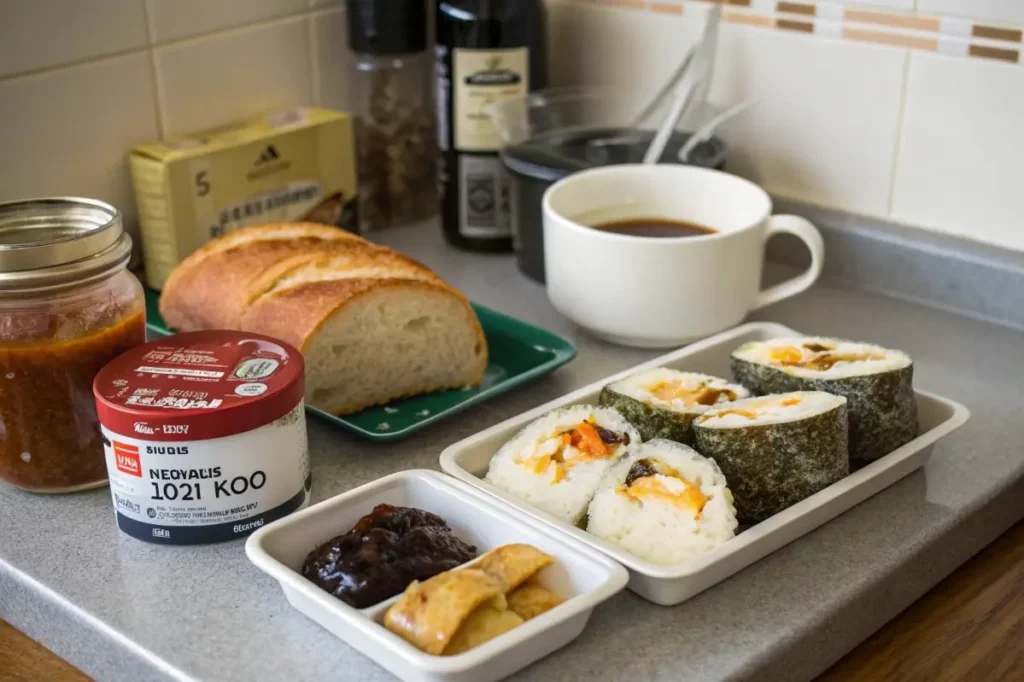
When and Where to Enjoy a Typical Japanese Breakfast
What time do Japanese eat breakfast? Generally between 6:30 and 8:00 AM on weekdays. But weekend brunches might stretch until 9:00 or 10:00, especially in urban zones where cafés open later. The question of “where” also influences your morning meal experience:
- At Home
- Many prefer the comfort of home-cooked rice, miso soup, and fish, especially families with children.
- Tools like a rice cooker with a timer or a small fish grill integrated into ovens facilitate easy morning prep.
- Ryokan or Hotel
- Travelers can savor a full spread with local produce, fresh fish, and regional specialties—like a unique miso variant or seasonal vegetable side.
- Traditional inns (ryokan) often serve breakfast in your room, showcasing the region’s best ingredients.
- Hotels commonly offer a buffet with both Japanese and Western items, catering to diverse palates.
- Cafés and Kissaten
- Some Japanese coffee shops serve “morning sets” with toast, boiled egg, and salad—particularly popular in Nagoya, known for its generous morning service.
- Perfect for those who want a quick meal but still enjoy a leisurely café atmosphere.
- School or Work
- Students might receive breakfast at school if the program supports morning meals.
- Busy professionals might heat leftover minced-beef-japanese-recipe at the office microwave if they arrive early.
Cultural Observations
- Family Bonding: In many homes, breakfast may be the only time the entire family sits together during weekdays.
- Respectful Silence: Some families keep conversation light in the morning, focusing on quietly enjoying the meal. Others use the time to discuss plans for the day.
- Seasonal Variation: In winter, piping hot miso soup or stew-based breakfasts become more common, while summer might see chilled tofu (hiyayakko) or cold noodles.
For a closer look at how environment and tradition converge, see discover-japanese-recipes for insights on seasonal ingredients that might appear in your morning meal. By tailoring your breakfast to time and place, you can replicate the typical Japanese breakfast experience almost anywhere.
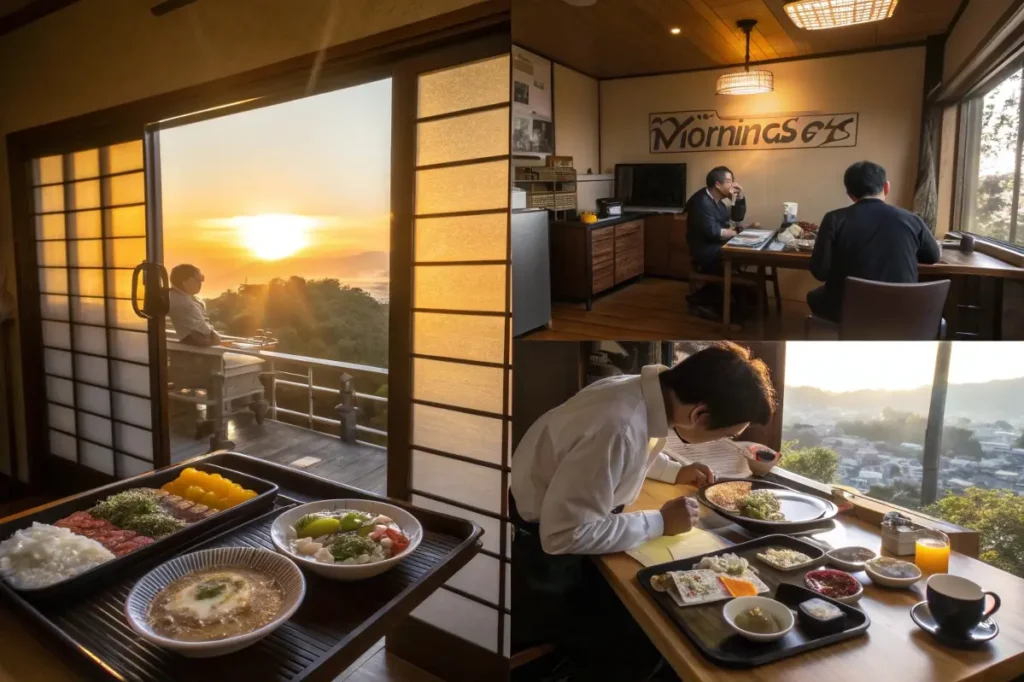
Common Questions About a Typical Japanese Breakfast
What is the typical breakfast in Japan?
The classic lineup: steamed rice, miso soup, grilled fish, pickled vegetables, and possibly an egg dish like tamagoyaki. It’s a balanced mix of flavors and textures, often eaten between 6:30 and 8:00 AM.
What is the Japanese breakfast rule?
Though not an official rule, it emphasizes including carbs (rice or bread), protein (fish, tofu, or eggs), and vegetables (pickles or soup) in one meal. This approach underpins the cultural priority on balanced, portion-controlled eating.
What time do Japanese eat breakfast?
Most start around 6:30–7:00 AM on weekdays, aligning with school and work schedules. Weekends can be more flexible, sometimes transitioning into a leisurely brunch closer to 9:00 or 10:00.
What do Japanese have for breakfast before school?
Children may enjoy a smaller version of the adult set—rice, miso soup, and fish or egg. Alternatively, quick options like onigiri or toast with jam are popular for busy mornings.
Do all Japanese breakfasts include fish?
Not necessarily. While fish is traditional, many families opt for eggs, tofu, or leftovers like japanese-curry-recipe-one-piece to save time. Coffee, toast, or cereal also appear in modern households.
Are there vegetarian or vegan versions?
Yes. Substituting fish with tofu, mushrooms, or vegetable-based proteins is common. Japanese-vegan-recipes can guide you in crafting a plant-based morning meal without losing cultural authenticity.
What about sweet breakfasts in Japan?
Traditionally, breakfast skews savory, but sweet tamagoyaki or leftover pastries sometimes show up. On weekends, families might indulge in fruit, sweet pancakes, or Western pastries.

History and Examples
History/Context
While modern lifestyles have reshaped breakfast in Japan, the roots of a typical Japanese breakfast go back centuries:
- Agrarian Beginnings
- Historically, rural communities started their day with rice or other grains—like millet—paired with pickled or foraged vegetables. Fresh fish was accessible if you lived along the coast. These early meals were about fueling labor-intensive farm work.
- Edo Period (1603–1868)
- As urban centers grew, so did diversity in breakfast foods. Merchants and samurai classes embraced miso soup and fish for their morning nourishment. Rice became a symbol of affluence, while pickles and soup offered variety without huge expense.
- Meiji Restoration (1868–1912)
- Western influences gradually entered daily life. Bread, butter, and coffee started appearing, though they remained luxuries for the upper class. Most households still relied on staple items—rice, soup, fish—due to cost and established preferences.
- Post-War Shifts
- After World War II, global foods (like bread, cereal, and instant coffee) spread throughout Japan. Convenience became a factor: families with both parents working sought quicker meals. Still, the fundamental idea of a balanced, portioned breakfast (rice, miso, side dishes) retained its hold on the culture.
- Contemporary Fusion
- Today, you’ll see everything from conbini onigiri to elaborate ryokan-style breakfasts. Many younger Japanese incorporate Western staples, but miso soup and rice remain comforting mainstays. Some families add leftover steak-japanese-recipe slices for a protein boost, bridging new and old flavors.
Why This Matters
The historical evolution reveals a flexible yet deeply rooted custom. Even as Japan modernizes and globalizes, the essential blueprint—carb, protein, vegetables, and soup—survives because it works: it’s nutritious, comforting, and culturally significant. Whether you’re traveling through Tokyo or replicating these dishes at home, the echoes of centuries-old practices resonate in each bowl of rice or spoonful of miso soup.
If you want a full timeline of how Japanese meals have changed and adapted over the eras, see japanese-old-fashioned-recipe to discover more about historically inspired cooking methods.
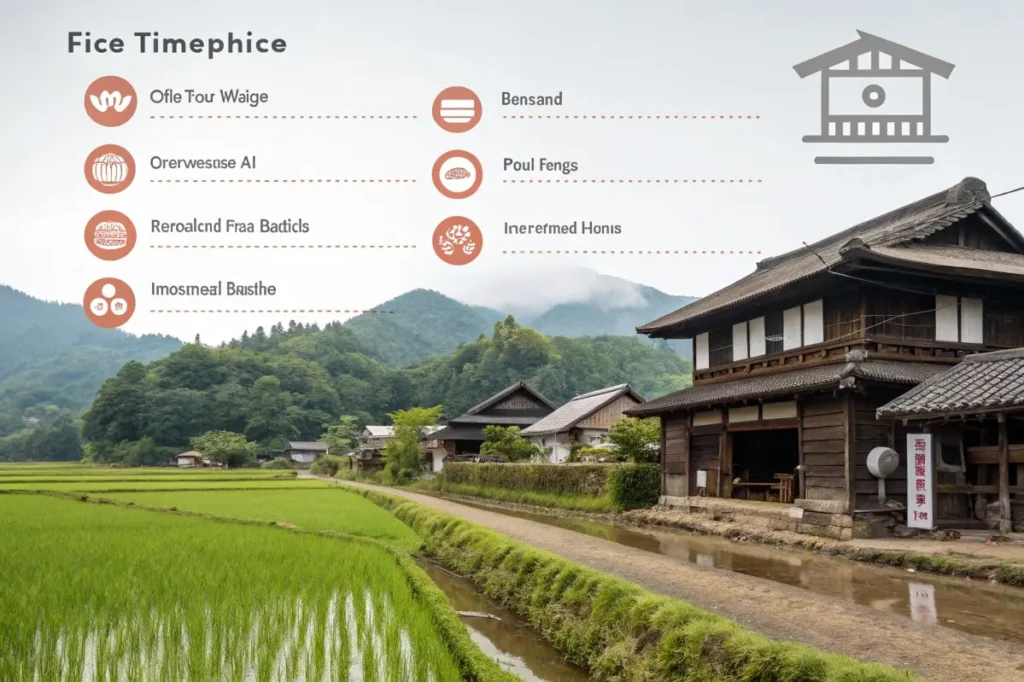
Practical Examples/Use Cases
- Small Apartment, Busy Student
- Scenario: A college student in Tokyo has 10 minutes before dashing to class.
- Breakfast: Instant miso soup, leftover rice from dinner, and a half-boiled egg quickly peeled and placed on top.
- Outcome: Quick, hearty, hitting the carb-protein-vegetable trifecta with minimal cooking fuss.
- Family Weekend Feast
- Scenario: Parents off work, kids out of school, time to cook.
- Breakfast: Grilled salmon, homemade miso soup with tofu, pickled cucumbers, tamagoyaki slices, and fresh fruit to finish.
- Outcome: Everyone relishes the slow morning, each dish shining in its own small bowl, reaffirming cultural ties.
- Office Worker On the Go
- Scenario: A salaryman stops at a convenience store on the commute.
- Breakfast: Salmon onigiri, a small container of pickled radish, and bottled green tea.
- Outcome: Portable, portion-controlled, and reminiscent of home-cooked staples despite the city rush.
- Western-Japanese Fusion Brunch
- Scenario: A young couple hosting a Sunday brunch for friends curious about Japanese cuisine.
- Breakfast: Toast with avocado-miso spread, scrambled eggs with furikake, a side of miso soup, and fresh salad.
- Outcome: Effortlessly merges Western brunch vibes with Japanese flavors, surprising guests who might only know about sushi or ramen.
Through these scenarios, the concept of a typical Japanese breakfast emerges as flexible, meeting diverse lifestyles. If your own routine is jam-packed, consider leftover japanese-curry-recipe-one-piece-2 as a quick morning fix. These everyday stories highlight how each dish—no matter how small—reflects Japan’s emphasis on mindful eating and balanced nutrition.
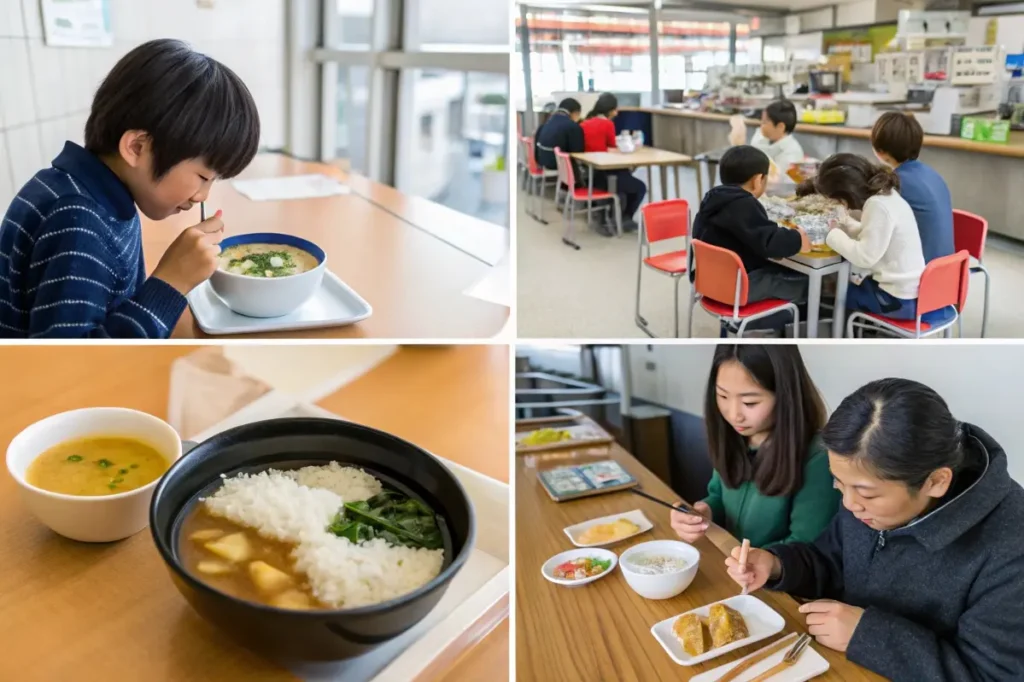
FAQs
1. What is the typical breakfast in Japan?
A typical Japanese breakfast generally includes steamed rice, miso soup, grilled fish, and pickled vegetables. Some households add items like tamagoyaki (rolled omelet), natto (fermented soybeans), or seaweed, striking a balance of flavors and nutrition.
2. What is the Japanese breakfast rule?
Although not an official rule, it suggests combining carbs (rice or bread), protein (fish, eggs, or tofu), and vegetables (pickles or soup) in one meal. This fosters a balanced approach, ensuring each nutrient group is represented.
3. What time do Japanese eat breakfast?
Usually between 6:30 and 8:00 AM on weekdays, matching work and school schedules. Weekends may see a shift to a later brunch style around 9:00 or 10:00.
4. What do Japanese have for breakfast before school?
Children often enjoy a smaller version of the adult set—rice, miso soup, fish or egg. If pressed for time, onigiri or toast might replace full meals, ensuring some basic nutrients.
5. Are modern breakfasts always traditional?
No. Many families mix Western items like toast, cereal, or coffee with Japanese staples. Leftovers also play a big role, turning dinner items into quick morning fixes.
6. How can I replicate these meals at home?
Focus on key components—rice, soup, protein, and vegetables. A small rice cooker and instant miso soup packets streamline prep. For more variety, consult japanese-vegan-recipes if you’d like plant-based alternatives.
7. Is fish mandatory?
Not necessarily. Although fish is iconic, alternatives include eggs, tofu, leftover steak-japanese-recipe, or spam in fusion households. Miso soup or pickles remain common for umami and tang.
Conclusion
A typical Japanese breakfast might look simple—just a bowl of rice, a piece of fish, a small dish of pickles, and a cup of miso soup—but beneath that surface lies a rich tradition of balance, portion control, and shared enjoyment. Whether you’re a student running out the door with an onigiri, a traveler sampling a full ryokan spread, or a family cooking up grilled salmon and tamagoyaki on a leisurely weekend, each version remains tied to the same culinary ethos: blending flavors in a way that satisfies the mind and body.
If you’re looking to bring a slice of Japan’s morning culture into your home, remember that consistency and adaptability go hand in hand. You can stick to the classic trifecta—rice, soup, fish—or modernize it with leftover japanese-curry-recipe-one-piece or avocado toast with a hint of miso. Regardless of your choice, the goal is straightforward: embrace variety, savor your meal, and start your day with a harmonious balance of nutrients.
By understanding the staples, the so-called “Japanese breakfast rule,” and how daily schedules shape these meals, you’ll appreciate why Japan’s approach to the morning table endures. Incorporate these insights into your own routine, and discover how simple, flavorful, and meaningful breakfast can truly be.
